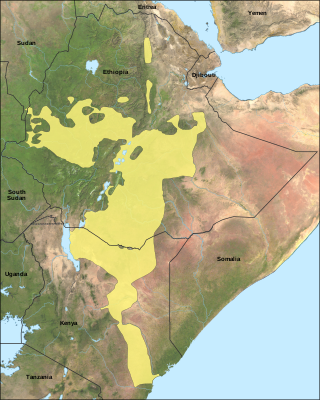
Michif is one of the languages of the Métis people of Canada and the United States, who are the descendants of First Nations and fur trade workers of white ancestry. Michif emerged in the early 19th century as a mixed language and adopted a consistent character between about 1820 and 1840.

The Austronesian languages are a language family widely spoken throughout Maritime Southeast Asia, parts of Mainland Southeast Asia, Madagascar, the islands of the Pacific Ocean and Taiwan. They are spoken by about 328 million people. This makes it the fifth-largest language family by number of speakers. Major Austronesian languages include Malay, Javanese, Sundanese, Tagalog, Malagasy and Cebuano. According to some estimates, the family contains 1,257 languages, which is the second most of any language family.

Oromo, historically also called Galla, which is regarded by the Oromo as pejorative, is an Afroasiatic language that belongs to the Cushitic branch. It is native to the Ethiopian state of Oromia and northern Kenya and is spoken predominantly by the Oromo people and neighboring ethnic groups in the Horn of Africa. It is used as a lingua franca particularly in the Oromia Region and northeastern Kenya.

Cypriot Arabic, also known as Cypriot Maronite Arabic or Sanna, is a moribund variety of Arabic spoken by the Maronite community of Cyprus. Formerly speakers were mostly situated in Kormakitis, but following the Turkish invasion of Cyprus in 1974, the majority relocated to the south and dispersed, leading to the decline of the language. Traditionally bilingual in Cypriot Greek, as of some time prior to 2000, all remaining speakers of Cypriot Arabic were over 30 years of age. A 2011 census reported that, of the 3,656 Maronite Cypriots in Republic of Cyprus-controlled areas, none declared Cypriot Arabic as their first language.
Khams Tibetan is the Tibetic language used by the majority of the people in Kham. Khams is one of the three branches of the traditional classification of Tibetic languages. In terms of mutual intelligibility, Khams could communicate at a basic level with the Ü-Tsang branch.

Fox is an Algonquian language, spoken by a thousand Meskwaki, Sauk, and Kickapoo in various locations in the Midwestern United States and in northern Mexico.

Kawaimina is a cluster of four languages and dialects of East Timor:

Babuza is a Formosan language of the Babuza and Taokas, indigenous peoples of Taiwan. It is related to or perhaps descended from Favorlang, attested from the 17th century.

Arrernte or Aranda, or sometimes referred to as Upper Arrernte, is a dialect cluster in the Arandic language group spoken in parts of the Northern Territory, Australia, by the Arrernte people. Other spelling variations are Arunta or Arrarnta, and all of the dialects have multiple other names.
Mangareva, Mangarevan is a Polynesian language spoken by about 600 people in the Gambier Islands of French Polynesia and by Mangarevians emigrants on the islands of Tahiti and Moorea, located 1,650 kilometres (1,030 mi) to the North-West of the Gambier Islands.

The Tharu or Tharuhat languages are any of the Indo-Aryan languages spoken by the Tharu people of the Terai region in Nepal, and neighboring regions of Uttarakhand, Uttar Pradesh and Bihar in India.
The Sigulai language is an Austronesian language spoken on Simeulue island off the western coast of Sumatra in Indonesia. It belongs to the Malayo-Polynesian branch of the Austronesian languages. Sikule is one of Northwest Sumatra–Barrier Islands languages, which are a sub-group of Western Malayo-Polynesian.

The Northern Formosan languages is a proposed grouping of Formosan languages that includes the Atayalic languages, the Western Plains languages, and the Northwest Formosan languages.
Balanta is a group of two closely related Bak languages of West Africa spoken by the Balanta people.
Favorlang is an extinct Formosan language closely related to Babuza.
Horpa are a cluster of closely related Gyalrongic languages of China. Horpa is better understood as a cluster of closely related yet unintelligible dialect groups/languages closely related to Horpa Shangzhai or Stodsde skad. The term Stodsde skad is a Tibetan name meaning "language of the upper village".
Intha and Danu are southern Burmish languages of Shan State, Burma, spoken respectively by the Intha and Danu people, the latter of whom are Bamar descendants who migrated to Inle Lake in Shan State. Considered to be dialects of Burmese by the Government of Myanmar, Danu has 93% lexical similarity with standard Burmese, while Intha has 95% lexical similarity with standard Burmese. Intha and Danu differ from standard Burmese with respect to pronunciation of certain phonemes, and few hundred local vocabulary terms. Language contact has led to increasing convergence with standard Burmese. Both are spoken by about 100,000 people each.
Southern Burun is a Western Nilotic language of Sudan. It is a dialect continuum with Burun proper, Mabaan/Ulu, and Jumjum.
Ati (Inati), or Binisaya nga Inati, is an Austronesian language of the island of Panay in the Philippines. The variety spoken in northern Panay is also called Sogodnin. The Ati people also speak Kinaray-a and Hiligaynon.
Yami language, also known as Tao language, is a Malayo-Polynesian and Philippine language spoken by the Tao people of Orchid Island, 46 kilometers southeast of Taiwan. It is a member of the Ivatan dialect continuum.










